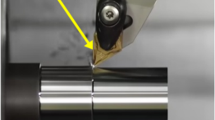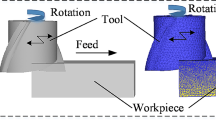Abstract
Part II of the present study is a comparative study of high-speed machining of Ti-6Al-4V and Inconel 718, focusing on a comparison between the effects of dynamic tool edge wear on cutting vibrations. This paper describes in detail how cutting vibrations were measured and how vibration signals were processed using a wavelet packet transform technique. A total of 60 high-speed machining experiments were performed, covering a range of cutting speed and feed rate conditions. The experimental results show that tool edge wear has a complex effect on the cutting vibrations. The vibration amplitudes in high-speed machining of Ti-6Al-4V can be higher or lower than those in high-speed machining of Inconel 718, depending on the particular cutting speed and feed rate employed. Analysis of variance reveals that both the cutting speed and the feed rate always play a statistically significant role in affecting the vibration amplitudes in all three directions, i.e., the cutting speed direction, the feed rate direction, and the depth of cut direction. It is also revealed that in high-speed machining of Ti-6Al-4V, four significant wavelet packets (W30, W32, W33, and W36) exist, depending on the particular cutting conditions employed. In high-speed machining of Inconel 718, two significant wavelet packets (W32 and W33) exist, regardless of the cutting conditions employed. The significant wavelet packets identified in part II of the present study can be used as features to detect and monitor tool edge wear in high-speed machining.
Similar content being viewed by others
References
Siddhpura M, Paurobally R (2012) A review of chatter vibration research in turning. Int J Mach Tools Manuf 61:27–47
Quintana G, Ciurana J (2011) Chatter in machining processes: a review. Int J Mach Tools Manuf 51:363–376
Toh CK (2004) Vibration analysis in high speed rough and finish milling hardened steel. J Sound Vibration 278:101–115
Tlusty J (1993) High-speed machining. CIRP Ann 42:733–738
Arvajeh T, Ismail, Fathy (2006) Machining stability in high-speed drilling—part 1: Modeling vibration stability in bending. Int J Mach Tools Manuf 46:1563–1572
Solis E, Peres CR, Jimenez JE, Alique JR, Monje JC (2004) A new analytical-experimental method for the identification of stability lobes in high-speed milling. Int J Mach Tools Manuf 44:1591–1597
Schmitza TL, Donalsonbm RR (2000) Predicting high-speed machining dynamics by substructure analysis. CIRP Ann 49:303–308
Budak E, Altintas Y (1998) Analytical prediction of chatter stability in milling—part I: General formulation. J Dyn Syst Meas Control 120:22–30
Devillez A, Dudzinski D (2007) Tool vibration detection with eddy current sensors in machining process and computation of stability lobes using fuzzy classifiers. Mech Syst Sign Process 21:441–456
Kang MC, Kim JS, Kim JH (2001) A monitoring technique using a multi-sensor in high speed machining. J Mater Process Technol 113:331–336
Johnson MA, Moon FC (2001) Nonlinear techniques to characterize precharter and chatter vibrations in the machining of metals. Int J Bifurc Chaos 11:449–467
Elwardany TL, Gao D, Elbestawi MA (1996) Tool condition monitoring in drilling using vibration signature analysis. Int J Mach Tools Manuf 36:687–711
Lee M, Thomas CE, Wildes DG (1987) Prospects for in-process diagnosis of metal cutting by monitoring vibration signals. J Mater Sci 22:3821–3830
Alonso FJ, Salgado DR (2008) Analysis of the structure of vibration signals for tool wear detection. Mech Syst Sign Process 22:735–748
Dimla DE (2002) The correlation of vibration signal features to cutting tool wear in a metal turning operation. Int J Adv Manuf Technol 19:705–713
Fang N, Srinivasa, PP, Edwards, N (2013) A comparative study of high-speed machining of Ti-6Al-4V and Inconel 718, part I: Effect of dynamic tool edge wear on cutting forces. Int J Adv Manuf Technol (in press)
Patra K, Pal SK, Bhattacharyya K (2007) Application of wavelet packet analysis in drill wear monitoring. Mach Sci Technol 11:413–432
Yen GG, Lin KC (2000) Wavelet packet feature extraction for vibration monitoring. IEEE Trans Ind Electron 47:650–667
Kunpeng Z, San WY, Soon HG (2009) Wavelet analysis of sensor signals for tool condition monitoring: a review and some new results. Int J Mach Tools Manuf 49:537–553
Coifman RR, Wickerhauser MV (1992) Entropy-based algorithms for best basis selection. IEEE Trans Inform Theor 38:713–718
Chuangwen X, Hualing C (2007) A research of tool wear recognizing based on wavelet packet pretreated and neural network. J Syst Design Dyn 1:760–770
Liu B, Ling S, Meng Q (1997) Machinery diagnosis based on wavelet packets. J Vibration Control 3:5–17
Mallat S (1989) A theory of multiresolution signal decomposition: the wavelet representation. IEEE Trans Pattern Anal Mach Intell 11:674–693
The MathWorks (2008) MATLAB Toolbox version 7.5 users’ guide. The MathWorks, Natick, MA
Wu Y, Du R (1996) Feature extraction and assessment using wavelet packets for monitoring of machining processes. Mech Syst Sign Process 10:29–53
Xue CW, Chen HL (2007) A research of tool wear recognizing based on wavelet packet pretreated and neural network. J Syst Design Dyn 1:760–770
Author information
Authors and Affiliations
Corresponding author
Rights and permissions
About this article
Cite this article
Fang, N., Pai, P.S. & Edwards, N. A comparative study of high-speed machining of Ti-6Al-4V and Inconel 718—part II: Effect of dynamic tool edge wear on cutting vibrations. Int J Adv Manuf Technol 68, 1417–1428 (2013). https://doi.org/10.1007/s00170-013-4931-z
Received:
Accepted:
Published:
Issue Date:
DOI: https://doi.org/10.1007/s00170-013-4931-z




